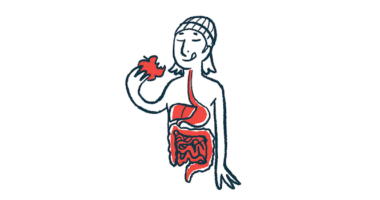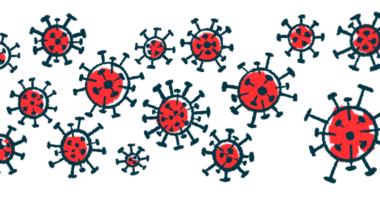Malnutrition, Inflammation Linked to Loss of Muscle Mass in SSc Patients
Low BMI, high inflammatory marker levels found to raise risk of sarcopenia

Sarcopenia, or a loss of muscle mass and strength, occurs in nearly one-quarter of systemic sclerosis (SSc) patients and is linked to a low body mass index (BMI) and high levels of C-reactive protein (CRP), according to a new study in Thailand.
Patients with a low BMI — a ratio of body weight to height — and higher levels of the inflammatory marker CRP were found to be at greater risk for such loss of strength and muscle mass.
Additionally, a significantly greater proportion of patients with sarcopenia had diffuse SSc, a more severe disease subtype that involves more areas of the skin and is more likely to affect internal organs.
“Our findings have value for evaluating sarcopenia development in SSc patients and could provide insights into giving patients better care and planning future studies,” the researchers wrote.
The study, “Prevalence and clinical association of sarcopenia among Thai patients with systemic sclerosis,” was published in the journal Scientific Reports.
Investigating muscle mass loss in SSc
SSc, or scleroderma, is a rare chronic disease characterized by excessive scarring of the skin and other organs due to abnormal immune responses against the body’s own tissues.
Most SSc patients have muscle symptoms, including weakness. Several factors — including malnutrition, chronic inflammation, immunosuppressive medications such as steroids, and lack of physical activity — are thought to potentially contribute to a higher frequency of sarcopenia among people with SSc.
However, only a few studies have assessed sarcopenia rates in people with the disorder. And little is known about this loss of muscle mass and strength in Asian SSc patients.
One previous study in Germany showed that the prevalence of sarcopenia among SSc patients was 22.5%, a rate that increased with age. Another study, in Italy, reported a prevalence of 42%.
Meanwhile, prior evidence suggested that sarcopenia frequency may be “higher among non-Asian patients than Asian individuals in both sexes,” the researchers wrote.
Now, a team of researchers at Khon Kaen University, in Thailand, sought to address the limited data on sarcopenia rates in SSc patients — as well as potential risk factors.
To that end, the team analyzed demographic, clinical, laboratory, body composition, and muscle data from 180 Thai adults with SSc.
All attended the university’s scleroderma clinic between July 2019 and April 2020. Their mean age at enrollment was 58.8 years, a third of them (33.9%) were men, and their mean disease duration was 6.2 years. More than half (52.2%) patients had diffuse SSc.
Muscle strength was assessed with handgrip, while physical performance was measured through a test of walking speed.
Participants who met the criteria for both low handgrip strength or low gait speed and low muscle mass were considered to have sarcopenia. Those with low handgrip strength, low gait speed, and low muscle mass were classified as having severe sarcopenia.
Results showed that sarcopenia was present in 41 SSc patients, reflecting a prevalence of 22.8%. Most of these patients (73.2%) had severe sarcopenia. About half of those with muscle mass and strength loss were 60 years of age or older. Sarcopenia typically affects the elderly, the researchers noted.
But they wrote: “Attending physicians should be aware of the risk of sarcopenia in SSc patients, not just the elderly, but also the middle-aged.”
The groups of patients with and without sarcopenia showed significant differences in several demographic, clinical, laboratory, and body composition factors.
Among them, a significantly greater proportion of patients with sarcopenia were men (51.2% vs. 28.8%), had diffuse SSc (73.2% vs. 46%), had high CRP levels at enrollment (48.8% vs. 24.8%), and low BMI at both disease onset (41.5% vs. 6.5%) and enrollment (70.7% vs. 11.5%).
Researchers classified CRP levels as high when they were greater than 5 milligrams per deciliter. Meanwhile, low BMI was defined as less than 18.5 kgs per square meter.
When adjusting for these and other potential influencing factors, only high CRP levels at enrollment and low BMI at disease onset “remained significantly associated with sarcopenia in SSc patients,” the researchers wrote.
Age, disease duration, disease severity, simultaneous health conditions, cigarette smoking, or immunosuppressive treatment were not identified as independent risk factors of sarcopenia in people with SSc, according to the team.
These findings highlight that “sarcopenia is common in SSc patients” — especially those with more severe disease — and support “the role of malnutrition and inflammation in the development of sarcopenia in SSc patients,” the team wrote.
“SSc patients with a low BMI and a high CRP are at risk of sarcopenia and should be monitored closely,” the researchers wrote, adding that “early detection of sarcopenia could lead to preventive measures with the aim of avoiding disability, impaired functional status, and hospitalization.”
Future studies, following SSc patients over time, are needed to confirm the risk factors of sarcopenia in this patient population, the team noted.







